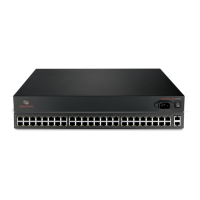Chapter 1: Introduction 3
console port and can enter commands in the Linux
®
shell or use the Command Line Interface
(CLI) utility.
NOTE: Only one root or admin user can have an active CLI or Web Manager session. A second root or admin
user who attempts to access the console server must abort or close the other user session.
WARNING: If automated cron jobs are running, a root or admin user login can cause the cron jobs to fail.
Web Manager
Users and administrators perform most tasks through the Web Manager. The Web Manager runs in
any supported browser (such as Netscape
®
, Internet Explorer, Firefox
®
or Mozilla) in any
supported computer that has network access to the console server.
The administrator can use the Web Manager to authorize users and configure security and ports. An
authorized user can access connected devices through the Web Manager to troubleshoot, maintain,
cycle power and reboot connected devices and change the user password.
Types of Users
The console server supports the following user account types:
• A root user who can manage the console server and its connected devices. The root user
performs the initial network configuration.
NOTE: It is strongly recommended that you change the default password avocent for root and admin before you
put the console server into operation.
• An admin user and optionally added additional users who are in the Admin group.
• Regular users who can access the connected devices through the serial ports they are
authorized for. Regular users have limited access to the Web Manager features.
Services
An administrator can enable or disable the following services based on the site security policy
through the Web Manager and the CLI:
•Telnet
•ICMP
• HTTP
• HTTPS
•RPC
•SNMP
•SSH v1
•SSH v2

